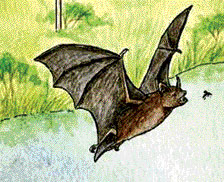Bat deaths could cost US economy billions
Call them creepy little creatures if you like, but insect-munching
bats are so valuable to US agriculture that their deaths could cost the
economy billions of dollars per year, experts said Thursday.
A fungal disease known as white nose syndrome, combined with the rise
in wind turbines which can ensnare the dark fliers, have killed off more
than a million of the bug predators in North America since 2006.

Their deaths mean the elimination of an important natural pesticide
which is worth at least 3.7 billion dollars per year to farmers, said
the study by US and South African researchers in the journal Science.
“Without bats, crop yields are affected. Pesticide applications go
up,” said Gary McCracken, head of the Department of Ecology and
Evolutionary Biology at the University of Tennessee, Knoxville.
“Even if our estimates were quartered, they clearly show how bats
have enormous potential to influence the economics of agriculture and
forestry.”
The analysis was based on “published estimates of the value of pest
suppression services provided by bats,” the study said.
The cost ranges “from about $12 to $173/acre (with a most likely
scenario of $74/acre) in a cotton-dominated agricultural landscape in
south-central Texas.”
Extending those estimates across the United States as a whole, they
found “the value of bats may be as low as $3.7 billion/year and as high
as $53 billion/year.”
McCracken’s co-authors were Justin Boyles of the University of
Pretoria in South Africa, Paul Cryan of the US Geological Survey and
Thomas Kunz of Boston University.
The study says that more than a million bats in North America have
died due to fungal diseases in the past five years, and that some
projections show that “by 2020, wind turbines will have killed 33,000 to
111,000 annually in the Mid-Atlantic Highlands alone.”
The cost analysis focused on the expense of pesticides but did not
include the effects of pesticides on the environment or human and animal
health.
“Not acting is not an option because the life histories of these
flying, nocturnal mammals — characterized by long generation times and
low reproductive rates — mean that population recovery is unlikely for
decades or even centuries, if at all,” said McCracken.
AFP |



